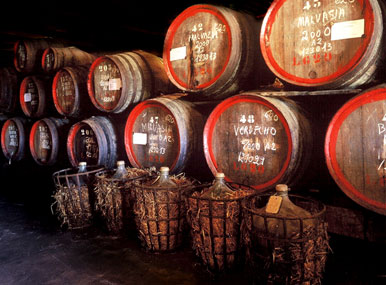 Madeira island is located in the Atlantic Ocean, approximately 600 kilometres from the coast of North Africa and is part of the an archipelago which includes the islands of Porto Santo, the Desertas and the Selvagens. It is the largest of the group and is approximately 735 square kilometres. This volcanic island is greatly composed of basalt and was discovered in 1419 by João Gonçalves Zarco, Bartolomeu Perestrelo and Tristão Vaz Teixeira on an expedition for Prince Henry the Navigator.
Madeira island is located in the Atlantic Ocean, approximately 600 kilometres from the coast of North Africa and is part of the an archipelago which includes the islands of Porto Santo, the Desertas and the Selvagens. It is the largest of the group and is approximately 735 square kilometres. This volcanic island is greatly composed of basalt and was discovered in 1419 by João Gonçalves Zarco, Bartolomeu Perestrelo and Tristão Vaz Teixeira on an expedition for Prince Henry the Navigator.
In 1495 by order of the king the island was divided up into captaincies divided among these 3 noble men who leased it to colonists for development. The first settlers were members of the noble Portuguese families who brought with them labourers and craftsmen from northern Portugal. Other settlers were of German, Genoese, Flemish, Polish, French and of British origin.
At that time, because the island was densely wooded, large areas of forest and vegetation were burned producing the required space for agriculture and simultaneously increase fertility of the soil. Terraces were constructed allowing vines and crops to be planted on its steep slopes. These were supported by stone walls and a series of irrigation channels called levadas were built to collect and transport water throughout the island for drinking and crop irrigation.
Cultivation of the lands was based upon a feudal system dating back to the fifteenth century. Landlords owned the lands then let them out to tenant farmers. The latter were subdivided into 2 types. If they lived in a house upon the land they were known as "caseiros" when they did not live upon the land they were known as "meiros". When Madeira was first colonized the land was worked by slaves. Most of them were from Africa and slavery persisted until 1775 when it was abolished in Madeira by the Marquis de Pombal.
In this century Prince Henry ordered plants of sugar cane from Sicily and Monemvasia (Malmsey) vines from Crete to be planted. Agriculture prospered and sugar cane became the main crop cultivated along with vines and wheat. In 1466 sugarcane became Madeira's most exported good directed to the Portuguese mainland, the Gulf of Guinea, African, Mediterranean and Northern Europe markets. Many other crops were introduced and are still grown on the island, such as bananas, custard apples, figs, avocado pears, cabbages, maize, apples, pears, beans, sweet potatoes and other cereals. With the decline of sugar sales, growers turned their attentions to planting vineyards.
During that century many colonists carried on arriving at the island. Among them was a Simão Acciaioly who is known for introducing the Malmsey Babosa variety.
The Madeira wine trade began when king John ordered his ships bound for Brazil to port at the island and take Madeira wine to his settlements. Later, when Charles II married the sister of King Alfonso VII, infanta Catherine, he issued an ordinance in 1665 banning the export of European goods to the English settlements overseas that excluded Madeira. This enabled Madeira shippers a monopoly of trade in America and the Caribbean and Madeira wine became a favoured drink in America and the West Indies.
This famous trade route is responsible for the world renowned Round Trip Wine "Vinho da Roda". The transportation of Madeira to those regions was made in the hold of the ships, which reached high temperatures when passing through the tropics. When the wines returned to Europe it was verified that these journeys greatly enhanced the quality of the wine.
Many British merchants began to settle on the island due to this flourishing trade and in 1680 there were almost 30 shippers. Of those 10 were British, 8 Portuguese, and another 10 were of various European nationalities. In 1780 there are records registering more than 70 British shippers on the island. The usual practice in those days was that where there was an English trading community, it was usual to establish a chamber of commerce known as a factory. The commercial, spiritual and physical needs of the British were looked after by the all powerful factors. In Madeira they built a church, cemetery, hospital and a capstan to load the wines on to the ship with the levy on shipments.
In the seventeenth century the exports to Europe were still secondary even though Portugal signed the Methuen Treaty in 1703 with England establishing that the Portuguese wines would pay less one third of the customs rates upon entering that country. Exports were still primarily directed towards the Indies and North America. Madeira wine was so important in this last country that the Declaration of Independence was toasted with it.
The growing demand for Madeira wine at that time had negative consequences because good quality wines were being blended with lower quality ones, produced mainly in the north coast of the island. Another negative aspect was the appearance of Madeira wines produced else where. To combat these negative aspects during that century efforts were made to create and implement regulations to ensure the quality of Madeira wine. The eighteenth century also saw a major development with regard to the character of the Madeira wine having been introduced 2 new techniques, fortification and estufagem.
The early nineteenth century brought with it an increase in exports but this was short lived. The great depression installed after the Napoleonic wars and the reopening of the French and Spanish ports allowed non Portuguese wines to enter the UK, harming Portuguese exports. Another 2 destabilizing factors are related to the North American civil war in 1861 that drastically affected exports to that continent coupled with the opening of the Suez Canal in 1869, changing the route of ships bound west.
The flourishing wine industry was severely affected when 2 major plagues struck the vines. Odium is a mildew that attacks the green part of the vines, creating white patches on the leaves and ultimately turning them grey. In 1852 it had spread all over the island and a decrease of 98% of production was registered because 90% of the vines were destroyed. Since vines were the main crop and source of revenue, this lead to an economic crisis, that bought on famine and later emigration.
This plague lasted from 1852 to 1862 and of the 70 British houses trading in 1850 only 15 remained. These bought up large stocks of old wine from those abandoning the island which in turn enabled them to persist in the wine industry.
The Odium scourge was overcome when a local grower discovered the beneficial effect of sulphur dusting a practice still used today. By late 1861 the vines were well recovered.
Phylloxera Vastatrix is a vine louse that originated in America and attacks both the root and the leaf of the vines. It appeared in Europe in 1860 and then spread to all the other countries in the world. By 1872 it reached the island and struck Funchal and Câmara de Lobos first and from there spread to vineyards all over the island. This plague lasted from 1872-1885.
New vines had to be planted and it was decided to restock with American vines such as Vitis Labrusca, riparia and Rupestris. Replanting was a costly, arduous and slow progress that led to Madeira loosing its principal markets. The European countries timidly resumed trade and records show that Britain imported about 11% and Germany and France were respectively taking 40% and 25%. Others such as the Scandinavian markets flourished after the plagues.
It was however the American market that was heavily affected and dwindled and when the prohibition law came to pass this market was non existent for 14 years.
The vines that persisted and are still used to this day to produce Madeira wines are Sercial, Verdelho, Bual, Malmsey, Tinta Negra, Terrantez and Bastardo.
Sources:
Cossart, Nöel Madeira the island vineyard, second edition published in 2011 by The Rare wine Company.
Hancock,David, Oceans of Wine, first edition published in 2009 by Yale University.
Elliot Trevor, The wines of Madeira, first edition published in 2010 by the author.
www.vinhomadeira.pt







